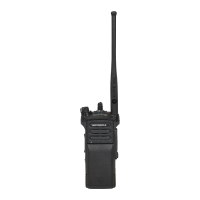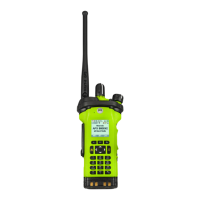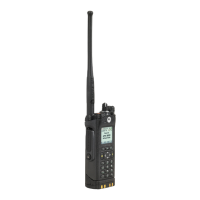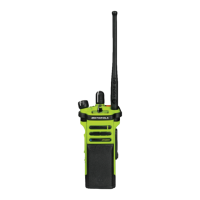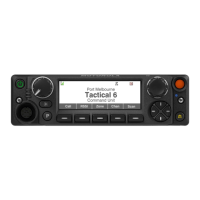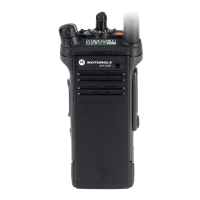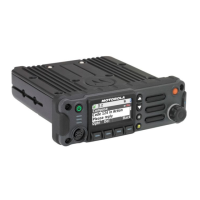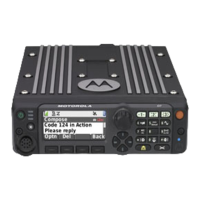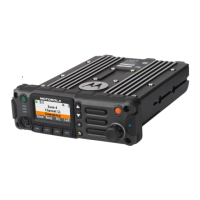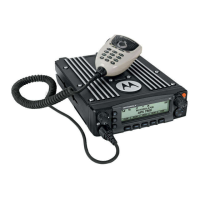Do you have a question about the Motorola APX 8000H and is the answer not in the manual?
Provides guidance on proper radio usage and care for efficient operation and longevity.
Provides a procedure for cleaning the external surfaces of the radio with mild detergent.
Provides instructions on charging the radio's battery, including safety precautions.
Explains how to attach the battery to the radio, including notes on non-Motorola batteries.
Details the procedure for attaching the radio's antenna, ensuring the radio is off.
Explains the procedure for powering the radio on and off, including power-up test indications.
Describes how to adjust the radio's volume using the On/Off/Volume Control Knob.
Identifies and labels the various physical parts and controls of the radio unit.
Explains how system administrators can program buttons for shortcuts to radio functions.
Lists and describes radio functions that can be assigned to buttons, like Bluetooth On/Off.
Explains how to use the Menu Select button to access radio features and menu entries.
Returns the radio to the Home screen or saves settings before returning.
Used to scroll through lists and options on the radio display.
Accesses data-related features, such as the Text Messaging Service (TMS).
Allows radio transmission for talking and initiating new calls.
Indicates battery level through LED, sounds, and fuel gauge icon on display.
Displays battery level using icons, with a blinking icon indicating low battery.
Explains the meaning of different LED status indications for radio operation.
Describes various icons on the LCD indicating radio status, calls, battery, and signal strength.
Indicates that the radio is actively scanning a predefined list of channels.
Explains icons and menu options for efficient use of the TMS feature.
Displays icons indicating different call types (radio, mobile, landline) and call direction.
Changes backlight and adds color bars to signal radio events like emergency alarms or low battery.
Lists alert tones and the conditions under which they are heard, such as self-test fail or out of range.
Explains phone call indicators and alert tones, including busy or unavailable states.
Explains how to select a zone, which is a group of channels, using various methods.
Details how to select a radio channel, which defines transmit/receive frequencies and parameters.
Allows saving current zone/channel to a button or softkey for quick access.
Describes saving frequently used zone and channel combinations to softkeys.
Explains how to save frequently used zone and channel combinations to programmable buttons.
Covers how to receive and respond to radio calls based on system configuration and indicators.
Details how to receive and respond to talkgroup calls, including LED and display indications.
Explains how to receive and respond to one-to-one private calls in trunking systems.
Describes how to receive telephone-like calls from landlines in trunking systems.
Outlines methods for initiating radio calls using zones, channels, IDs, or talkgroups.
Instructs on how to make a talkgroup call by selecting a channel and using the PTT button.
Explains how to initiate a private call to an individual radio, including call alerts.
Details sending an enhanced private call or call alert page when no response is received.
Describes how to make telephone calls to mobile or landline phones from the radio.
Ensures a channel is clear before transmitting by removing background noise.
Describes methods to monitor a channel for activity using buttons or the menu.
Introduces ViQi, a virtual assistant for managing the radio and performing lookups via voice commands.
Helps look up information like license plates and driver's licenses using voice commands.
Provides steps to interact with ViQi Virtual Partner using voice commands for information lookups.
Explains various advanced call functionalities available on the radio.
Enables private, individual calls with privacy for ASTRO conventional systems.
Defines groups for conventional system users to share a channel.
Enables calling the dispatcher on a different talkgroup when the primary one is congested.
Allows dispatchers to temporarily reassign radios to a specific channel for communication.
Provides Dynamic Zones to store frequently used channels for conventional or trunking.
Guides on entering a dynamic zone to select a specific dynamic channel.
Describes how to save a channel from a list into a dynamic zone.
Explains how to remove a channel from a dynamic zone.
Clones conventional zones from one radio to another using a clone cable.
Details the procedure for cloning zones between compatible radios.
Provides address-book capabilities for initiating calls using aliases or IDs.
Explains how to make a private call to a contact stored in the radio.
Explains scan lists for monitoring voice activity by cycling through channels.
Allows changing scan list members and their assigned priorities.
Explains how to change the scan list status icon for displayed channels.
Describes how to view and change the priority status icons for channels in a scan list.
Explains how to enable or disable the radio's scan function.
Temporarily removes unwanted channels from the scan list that generate noise.
Allows sending individual call alert pages to notify users or verify radio activity.
Describes methods to send a call alert page using quick access buttons or the radio menu.
Explains the emergency feature for critical situations, overriding other communications.
Sends an emergency alarm or call on the current channel during an emergency.
Outlines scenarios and behaviors during emergency operation, like no emergency capability or out-of-range situations.
Describes how to exit emergency mode, potentially initiated by the dispatch console.
Allows sending a data transmission to the dispatcher identifying the radio in an emergency.
Grants priority access to a talkgroup for emergency calls in trunking systems.
Enables emergency calls with an activated microphone (hot mic) for group communication.
Provides priority access for emergency alarms and calls on conventional or trunking systems.
Allows sending emergency alarms and calls with hot mic to groups of radios.
Sends an emergency alarm without triggering audio or visual indicators.
Transmits Bluetooth Low Energy (BTLE) signals and emergency information to nearby radios when in emergency mode.
Transmits and receives Emergency Find Me beacons to locate radios.
Guides on entering the Fireground Zone Channel for conventional operations.
Enables an evacuation tone to be heard by transmitting and receiving radios.
Explains how to respond to tactical alerts triggered by the Incident Commander.
Identifies transmission start/end by displaying caller name or ID.
Describes normal transmission procedures within TPS channels.
Details TPS emergency transmission, including emergency beacon and call de-key sidetone.
A feature that detects user trouble via tilt or motion, triggering alarms.
Explains the alerts and display notifications when the Man Down feature is activated.
Provides steps to test the Man Down feature's activation based on radio position.
Provides automated data application registration for the radio upon turn-on.
Explains how to select or change the Automatic Registration Service (ARS) mode.
Allows users to log in with a username for identification in services like text messaging.
Details the step-by-step process for logging into the radio using two-factor authentication.
Explains how to log out of the radio, with options to clear private data.
Enables sending/receiving messages and running database queries directly from the radio.
Describes how to send predefined quick text messages using buttons or the menu.
Allows appending priority status and/or request reply to outgoing text messages.
Explains how to receive text messages using data/TMS buttons or the radio menu.
Guides on accessing and viewing messages stored in the radio's inbox.
Details how to reply to a received text message, including using quick text options.
Stores sent messages in the Sent folder, with the most recent at the top.
Allows sending/receiving messages and running database queries with two-factor authentication.
Enables secure login with username, unit ID, password, and passcode for authentication.
Details the step-by-step process for logging into the radio using two-factor authentication.
Explains how to log out of the two-factor authentication session, with options to clear data.
Provides high-level voice security on trunked and conventional channels, entering encryption automatically.
Integrates GPS/GLONASS information to determine the radio's geographical location.
Explains features related to controlling trunking systems.
Explains how to turn on the radio's Bluetooth feature using the menu or a button.
Explains how to turn off the radio's Bluetooth feature using the menu or a button.
Provides RF energy exposure and safety guidelines for portable two-way radios.
| Channel Capacity | 1000 channels |
|---|---|
| P25 Phase 1 & 2 | Yes |
| GPS | Yes |
| Bluetooth | Yes |
| Wi-Fi | Yes |
| Frequency Range | 764-870 MHz, 136-174 MHz |
| Modulation | FM, P25 |
| Operating Temperature | -30 to +60 °C |
| Encryption | AES, DES |
| Water Resistance | IP68 |
